Over the next year, I plan to post about my current project: REVISIONING FLIP DOLLS. I received a Conant Grant from the Potomac Fiber Arts Guild and as part of this project, I am: working with homeless womem at N. Street Village in DC making flip dolls; interviewing professional artists who make flip dolls, and making my own flip dolls. And more... I will be writing about all of these efforts in these pages. So stay tuned..... 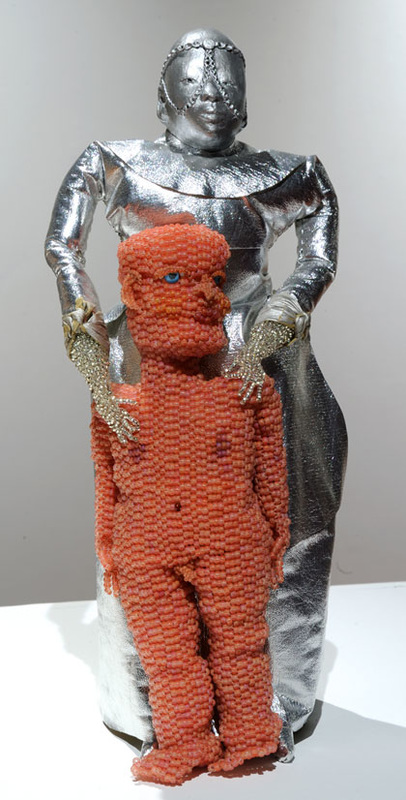 Joyce J. Scott, Wet Nurse, 2002, beadwork and leather (Courtesy of Goya Contemporary Gallery, Baltimore, MD, photographed at American University’s Katzen Museum January-March 2016 exhibit, Circle of Friends) For more of Joyce Scott's images, see her Pinterest page. Joyce J. Scott, Wet Nurse, 2002, beadwork and leather (Courtesy of Goya Contemporary Gallery, Baltimore, MD, photographed at American University’s Katzen Museum January-March 2016 exhibit, Circle of Friends) For more of Joyce Scott's images, see her Pinterest page. Special Feature this month: Interview with last month's MacArthur Grant winner, Joyce J. Scott: As a part of my project Revisioning Flip Dolls I am interviewing a series of professional artists who make flip dolls or whose work is similar thematically or stylistically to the flip doll. Flip or Topsy-turvy dolls are two-sided dolls connected in the middle at the waist, and separated by a skirt, which flips over to cover one side when the other side is revealed. My first interview, two phone conversations back in April of 2016, was with renowned multimedia artist, (weaving, printmaking, quilting, beadwork, and more recently, performance and installation art.) Joyce J. Scott. I heard about Scott from a fellow fiber artist, Julie Booth and also from Kimberly Wallace Sanders, whose books (Mammy: A Century of Race, Gender and Southern Memory, Skin Deep, Spirit Strong: The Black Female Body in American Culture) I also read as part of this research. Scott has exhibited widely and won multiple grants and has also taught at many prestigious art centers throughout the world. Her work is in places such as the Metropolitan Museum of Art, Museum of Fine Arts in Boston and the National Museum of American Art at the Smithsonian. Recently she won the 2016 Maryland Baker Artist award. I just discovered that she won the MacArthur Genius award this September 2016. Here are links to two recent articles in the Baltimore Sun: Joyce Scott profile Joyce Scott winds MacArthur genius grant She very graciously took time out of her busy schedule to talk to me, and for this I am very grateful. From protesting against injustice and inequality to her creative process The interview with Scott took place over two phone calls. In the first, we talked about the Nanny series and about flip dolls. In the second we addressed a wide range of topics, including Scott’s current focus. We started with the personal story of her own mother’s experiences of racism when she worked as a caregiver for white families, and then Scott’s motivation to speak out in her work against injustice and inequality, whether it be racial, social or gender based. We also talked about her interest in collaboration, giving back to her own community, and to communities in other countries in her extensive travels. We talked about the creative process, the importance of artistic media as inspiration, how she approaches her work and what motivates her. Scott’s work deals with far ranging issues but the impact of her work is personal and intimate. This directness and at times provocativeness, came up in our discussion, reminding me that it is the personal aspect of politics that has the most power. Scott’s origins, her quilt-making mother Joyce Scott doesn’t make flip dolls per se and doesn’t call what she makes dolls, but some early beaded figures (1980’s-90’s) from her Mammy/Nanny series, are strongly related to the theme of flip dolls. In this series, a tall black woman holds a tiny white child and a small black child lies neglected off to the side. This series, Scott has described elsewhere, is a reflection back to her own mother’s experience of being a child-care provider when Scott was a child in Baltimore. Her mother was born in 1916, in South Carolina, and had worked in the fields picking cotton. She moved to Baltimore in 1940, working in factories, and later as a child-care provider for white families. Scott’s mother is herself a renowned quilt-maker and sewing and craftwork were a constant in spite of her busy life. Scott remembers feeling neglected by her mother’s need to spend long hours caring for these children who as they grew insulted her mother. The Nanny series of figures reflect this sense of neglect as well as the strength and power of the black nanny, who remained strong in spite of the way she was treated. How is Scott’s work connected to flip dolls? The depiction of the relationship between a black caretaker and a white child has an obvious connection to the early flip dolls in which black and white dolls alternate on each side of the doll. I have read various explanations for the meaning of the black white flip doll, but the one that makes the most sense to me is the explanation that slave mothers made these dolls to help their daughters cope with an intolerable situation. The dolls also represent the interconnectedness between white slave owners and the slaves, where in spite of the outward power differential, the black slave caretakers often held a powerful role of intimacy and influence over their white charges. Scott’s insight into flip dolls During our first conversation about flip dolls. Scott told me that coincidentally she had just given someone a flip doll as a gift, not her own creation. I asked Scott her take on the meaning of black-white flip dolls, mentioning a quote I had read recently: “Long past their prime as playthings, topsy-turvy dolls continue to ignite discussion in large part because they resist being squarely fixed to one meaning-instead they flip back and forth between ideas that conflict even as they coexist.” by performance artist Cori Spenser in an article by K. Tait Jarboe in The Atlantic. Scott had addressed these contradictions, first on a personal level in her Nanny series. The works “speak to the fact that this woman who was everything except a wet nurse had such a role in the family’s life but was then poorly treated…how can you be mean to her and disrespect her but entrust her with the care of your own beloved child? The Nanny series speaks to the humanity of the servant in having to embody these contradictions. Of course some of the nannies weren’t nice but most were nice, took care of children as children. When the black caretakers own child believes that the nanny is showing more love, whether or not this is true, what choice did the mother have?” Also, speaking to the contradictions in the lives of slaves and white slave owners that these early black/white flip dolls were based on, Scott talked about: “the blackness of white women and whiteness of black women-many white women were closer to slaves than to other white women. Isolated, the person they saw every day was the slave. The white women spoke more similarly to the slaves and couldn’t read or write, except verses from the bible-so the women who owned the slaves were sometimes also ‘black’ in that they were close, whereas the slave girls were often ‘white’ from white slave owners sleeping with their slaves….” She said the two-sided doll, “represents a scale-weighing justice, what justice holds. It changes each time you weigh it. What weights the most often has the least value.” She also said that the “flip doll is also about pulling up skirts and seeing hidden/nether/dark parts.” In my experience of making flip dolls, I have to find a way for each side to weigh the same so that it can hang evenly. To me, the flip doll is about finding a way to give equal weight to each side. And the nether parts comment is something I can relate to as well in my work, the balance between light and dark, good and evil, opposites of all types and the need to find wholeness or equilibrium. Our second conversation was more wide-ranging and I reproduce it here as a conversation: First Scott apologized for not being able to speak to me the first couple of times I called. “Every time I turned there was something different, always important-had to finish an art work, beaded piece I’m working on is 46” x 31 ½” good enough to show. Took a couple years to make.” Erika Cleveland: I notice a theme of interconnected/intertwined bodies in much of your work, in the Mammy series and in many of your figurative beaded jewelry pieces and the works of beaded figures on glass. Joyce Scott: Sure for some of the pieces there is a meaning to this. But mostly it’s a conceit, a design that I like to work with. EC: not so much a metaphor? JS: don’t know if it is, depends on each piece. Things are just designed and feel good to make that way and other things, directly relate to whatever the concept was. So what I’m saying is that I’m not locked into anything. Each piece asks me to do something different. EC: do you start from the medium or is it the theme or is it both ways? JS. Each piece, it’s different, and that’s one of the great things about me going into the studio. I may just go in and fiddle around. I may have something that’s been bugging me for a long time. Or I might just sit there and look stupid and just keep messing around until something happens. I really seldom have that kind of direction unless I’ve already made a piece…a piece where I hadn’t finished what I had to say. That’s kind of how a series happens. Each one asks the other and tells me a story that extends the original concept. EC: Some does come from personal experience, as in the “Mammy dolls” JS: That one did come from my mother…. EC: …personal stories, JS: I don’t know how that’s not true for any artist, any art form. Some things happen from the broader story, but smidges in there can really shed light, like …I hear Prince-and might sing a Prince song, you know what I mean? EC: culture, own history or more global, universal… JS: …world culture, I’m influenced a lot by pop culture, what’s popping right now… also as an African American woman how black culture has if not insinuated, definitely directed a lot of things that are popping around the world and it comes out of that culture. I just watched a 2016 World street dancing competition and not one African American, they were Asians and Europeans, but that started with us. We have influenced a lot, certainly music, a lot of pop stuff. And also, I’m old enough to remember the 60’s and 70’s and a lot of that social concern started with, we were in this giant…the way we did things like Black power, it started things for a lot of other people like Hawaiians, people of color in other countries. Indigenous Hawaiians were doing things like black power and certainly people further in the Pacific like New Guinea and Australia, it comes out of this…Wait, Don’t think that I’m saying that we’re the only group that does that. But that’s who I am so I can see it clearly. EC: the only way that makes sense is to start from who you are. Can we talk more about medium and materials? JS: I started with weaving. I’ve always done beadwork but worked on looms, crochet. I started as a fiber artist, those are things my mom did. A lot of textile motivated and oriented my work. Loved that feel and loved that it was something I could wear and sleep under or make something else out of, great for me to walk on. But I became challenged by translucency and the idea of light moving through something and it was very different with textiles where light would be absorbed or bounce off the surface. EC: when did that start? Your interest in translucency. JS: Hippie days. I wanted to be a hippie. 70’s. When I was first inspired by translucency. But when I first started doing residencies or teaching or hanging out at different art or craft schools like Penland and Haystack. By that time I was either watching what was happening in glass studios or I was also working in glass studios. Also at Haystack in 1976 learned the peyote stitch or … it’s also called diagonal weaving, in Maine and that changed everything for me as a beader because before that as a weaver I was on a loom or sewing into fabric and this peyote stitch allowed me to do needle, thread and bead and had the luxury of being as inventive and improvisational as I wanted to be. I wasn’t bound to anything. No loom. No fabric. That’s the way I think. I see now that it wasn’t a struggle. It was a smart progression or evolution from one form of fabric or thread into another. But this thread having beads on it. EC: did that take you to 3D? JS: no was always doing 3D. when I was doing fiber I was doing 3D fiber. EC: peyote stitch was a technical freedom. JS: Yes, it allowed me to do the kinds of things that I do. It also allowed me to apply the things to something else like the Mammies and the glasswork that I’m doing. It was the language that I should be speaking. Does that make sense? …truly my language that I am most fluent in. EC: a lot of sense. What are your influences? Did other women artists influence you? JS: Really the usual suspects, of course I studied them at art school etc. But it was more culture. More my traveling and being with the Guatemalans and going to market with them…watching how they dress. Being with the Kunas in San Blas Islands. I did that. Remember that was hippie times too so that’s what you did. You stay and immerse yourself as an anthropologist or archeologist. That’s what you’d say to yourself but you just wanted to hang out. And it was the liberty to go places and know you had complete freedom though sometimes there was also the danger. Like couldn’t go to Guatemala because the revolution was about to happen. They were about to have a coup and that was about to happen, in about two years. And I went to Cuba-certain places, in the 70’s early 80’s. It wasn’t what it will be in the next two years. Soviet Union was still there. So all I can say is all of that for me is what propelled me to be making art the way I make it. Always had great liberty in what I do. I’ve always been uncomfortable with the status quo, don’t like when someone is hanging something (shit) on me, unless I have something to do with the status quo. If someone is expecting me to submit, that’s probably not what I’m going to do. If I had some part in it, then I’d be happy to…
EC: Tell me about collaborations? with other cultures? JS: They’re teaching me or I’m teaching them, that’s the way of collaboration. I sang in a rock band for two years after I graduated. That’s a form of collaboration. The whole life thing is like that. For example, I and five other people went to South Africa two years ago. We went for almost a year. We went specifically to just bum rush and make beadwork with people and show them our stuff and they showed us theirs. I mean we did it on people’s dining room tables. Literally. That was wonderful. And we weren’t subsidized by anybody. We went because you can actually do that with, this really über-global consciousness we have now. It’s all much more expensive than when I was younger but you really do have the opportunity to do that. EC; Please talk about the provocative nature of your work. JS: You know. Everybody’s got the idea of what’s provocative. Some people tell me I don’t have the filters you should have and I tell them where can I get the filter? Is it in a filter store? EC: Are you talking about freedom? JS: Provocative means if I believe that this is my best voice as a visual artist/performing artist. then I’m going to talk about the same thing that you would talk about. If you’re pissed off about politics or at least in pursuit of some knowledge, then you’d talk about it your way. Well this is my way. One of the biggest fights we have is about ethnic prejudices or racism, I’m always going to be talking about it. I’m always going to be talking about misogyny and how those tentacles are in race and class and that’s just what I’m going to do. And it’s very tiring. I get tired of it too. The world doesn’t seem to change. I am completely for Harriet Tubman on the 20 dollar bill, (this was just in the news as we spoke)and she will be a fount for other people to draw from but I don’t know what it will change. You could not change it into two tens. Only reason that happened was because people kept yelling about it. I’m not a martyr. I’m not going to set things on fire. I’m not a marcher. But I hope through my art and my performance that I have the ability to… EC: You already sort of answered this question but what are the obstacles you still see? What are you still fighting against? JS: I’m fighting what everybody else is. I live my life like everybody else does and so consequently and I live in a challenged community. First I live in Baltimore but secondly I live around the corner from where the CVS was set alight (last year during the riots after the police trials related to their abusive treatment which led to the death of Freddy Grey.) So every day I see what happens. And every day I not only see people selling drugs but I also see those people working very hard to make life good for them and for their children. It’s the same struggle and the same fight. So we as humans gain. I don’t see how it will be that different. Our tools will be different. But we’re evolving tools that make it easier or harder but we as humans? I don’t know. EC: What’s on the horizon? JS: I’m going to keep doing this large piece I told you about. It’s taken me back to beadwork. I’ve been doing a lot of glass and beadwork and I want to keep working on painting and doing print and that’s something I haven’t done truly in earnest. I’d really like to do that. The other thing is that I am an artist in residence at an art program called Motor House http://motorhousebaltimore.com in Baltimore. The ‘geezer in residence” They give me a stipend and a studio. I don’t want people in the house, so instead of that I’ll be able to have people in the studio doing different things. I’ve already set up projects with folks so I’ll be able to extend what I have, knowledge to others and they’ll have a safe place to create as well. EC: Can you speak about aging process. Do you think about that? We have our limited life. JS: It took so long to get to the phone. The studio’s on the third floor and what I think about all the time is if it gets too hard to get to the third floor, then I’ll bring the stuff to the second or first floor. The question is will I have enough time to create all the things that keep popping into my head that I think are worthy. That’s what I’m wondering. I wonder how I can make it. And then, Stephen Hawking, I look at him and he does it with a computer and I guess I could do that. I don’t think I’ll be stymied by my age ever unless I go where my mom went which was dementia. As long as I can walk or be pushed around, that’s what I’m going to do. EC Incredibly inspiring. Thank you. JS Go on youtube, see the music too. EC. Thank you.
1 Comment
Two weeks ago I installed my solo show at the Torpedo Factory, TAG Gallery, with the help of some fellow artists. It was challenging getting it all together but once it was all in place, I was thrilled. It's an amazing feeling to see all my dolls together in this wonderful space. I want to share this experience with you at a special reception on October 13th from 6-8 p,m. I hope that if you are in the area you will be able to come and see the work. I'm also offering a special discount to those who attend this reception. See below for more information. The show represents the culmination of the past four years of doll making, from the first dolls like my Gypsy Polly to my latest large dolls and felted panels (see below for detailed description of two of the panels.) Here's some more information about this show: Show statement: What would it be like to put on a mask and become a wolf? What if you could transform a dragon from a dangerous monster into a trusted friend? What if you could switch from one side to another side of your personality by flipping a swing from one side to the other? What if you could shed your skin like a snake or a lobster when you are ready to grow to the next stage? What if your insides could show on your outsides? What if fairy tales had something to tell us in our lives, something practical and real? These are the kinds of questions that the artist has been exploring over the past couple years in creating these dolls. Masks, cloaks, animal skins, trees, energy systems and seeds all show up as themes in her work. Here for the first time are all of these themes in one place. The show represents the evolution of the last four years of the artists’ explorations in doll-making. The idea of making panels emerged more recently, as a way of exploring themes that would be developed further in the larger dolls. In addition, the panels allow a relatively shorter time from idea to creation, compared to the large dolls. A panel can be completed in a week. This is in contrast to the slow and sometimes painstaking process of working on the larger dolls, which could sometimes take more than a year to complete. 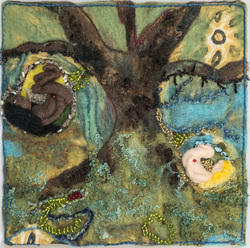 This panel is called Garden of Eden Revisited. I started making the panels during the construction of my large dolls, Tumnus, Baba Yaga and Vasilisa. The panels are quicker to make and provide a welcome relief to the much longer process of making the large dolls, which can take as long as six months to a year. They were also a way of working out some of the design problems and themes for the larger dolls. This one. Garden of Eden, is about the ways in which we are connected to nature. For the Baba Yaga doll, I wanted to make a skirt of "newly hatched souls" and so, in the panels I played with various ways of depicting these souls. Here, the souls grow from the tree of wisdom, upside down and ready to hatch. 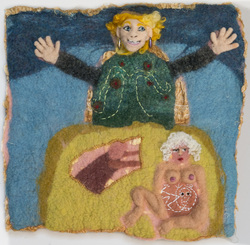 This panel is called The Garden is in Me. Here again is the tree as a symbol of the seasons of life and death. A strange, archetypal goddess-like woman sits under the tree, holding the bones of some ancestor soul within her body. Out of death comes life. Out of the bones of those who came before us come our "new" ideas and new life. I've decided, for this reception to offer a special deal to you, my loyal newsletter readers, for one night only. I want to offer the panels for 10% off and the dolls for 20% off. All you have to do is come to the reception for Upside Down, Inside Out: The Fanciful in Daily Life and you can get this discount for one night only on my doll art.
|
ErikaI've been making dolls for about ten years now. I believe that dolls serve as representations and reminders of the best part of ourselves. I am excited to share with you here my learnings about new methods and techniques for doll making and healing. So glad you are here! Categories |
Proudly powered by Weebly

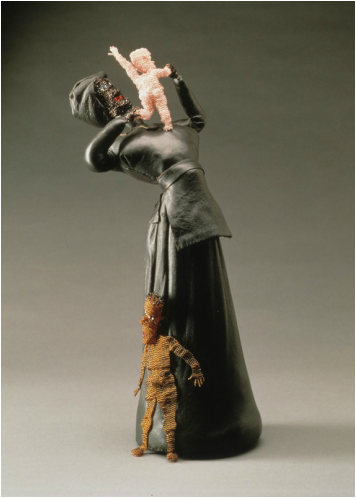
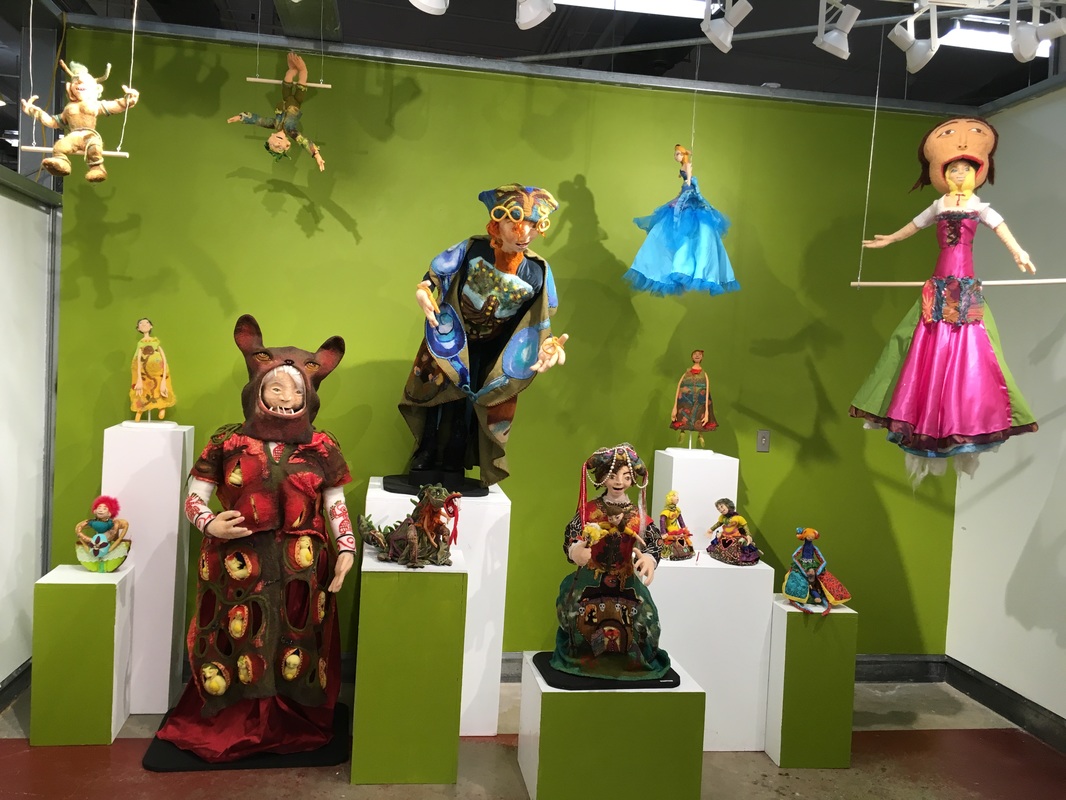
 RSS Feed
RSS Feed